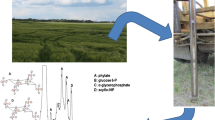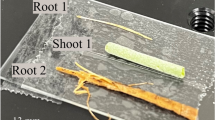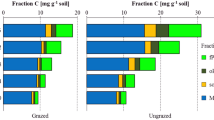Abstract
We examined the potential of stable-isotope Raman microspectroscopy (SIRM) for the evaluation of differently enriched 13C-labeled humic acids as model substances for soil organic matter (SOM). The SOM itself can be linked to the soil water holding capacity. Therefore, artificial humic acids (HA) with known isotopic compositions were synthesized and analyzed by means of SIRM. By performing a pregraphitization, a suitable analysis method was developed to cope with the high fluorescence background. Results were verified against isotope ratio mass spectrometry (IRMS). The limit of quantification was 2.1 × 10−1 13C/C tot for the total region and 3.2 × 10−2 13C/C tot for a linear correlation up to 0.25 13C/C tot. Complementary nanoscale secondary ion mass spectrometry (NanoSIMS) analysis indicated small-scale heterogeneity within the dry sample material, even though—owing to sample topography and occurring matrix effects—obtained values deviated in magnitude from those of IRMS and SIRM. Our study shows that SIRM is well-suited for the analysis of stable isotope-labeled HA. This method requires no specific sample preparation and can provide information with a spatial resolution in the micrometer range.

Analysis of the isotopic composition of humic acids by Raman microspectroscopy in combination with isotope ratio mass spectrometry and nanoscale secondary ion mass spectrometry.







Similar content being viewed by others
References
Dore MHI. Climate change and changes in global precipitation patterns: what do we know? Environ Int. 2005;31(8):1167–81.
Haynes RJ, Naidu R. Influence of lime, fertilizer and manure applications on soil organic matter content and soil physical conditions: a review. Nutr Cycl Agroecosyst. 1998;51(2):123–37.
Khaleel R, Reddy K, Overcash M. Changes in soil physical properties due to organic waste applications: a review. J Environ Qual. 1981;10(2):133–41.
Jeffery S, Verheijen FGA, van der Velde M, Bastos AC. A quantitative review of the effects of biochar application to soils on crop productivity using meta-analysis. Agric Ecosyst Environ. 2011;144(1):175–87.
MacCarthy P. The principles of humic substances: an introduction to the first principle. In: Ghabbour EA, Davies G, editors. Humic substances: structures, models and functions. Cambridge: The Royal Society of Chemistry, 2001. pp. 19–30.
Kögel-Knabner I. Analytical approaches for characterizing soil organic matter. Org Geochem. 2000;31(7–8):609–25.
Balesdent JM, Mariotti A. Measurement of soil organic matter turn-over using 13C natural abundance. In: Boutton T, Yamasaki SI, editors. Mass spectrometry of soils. Boca Raton: CRC press, 1996. pp. 83–111.
Steinbeiss S, Gleixner G, Antonietti M. Effect of biochar amendment on soil carbon balance and soil microbial activity. Soil Biol Biochem. 2009;41(6):1301–10.
Mueller CW, Weber PK, Kilburn MR, Hoeschen C, Kleber M, Pett-Ridge J. Advances in the analysis of biogeochemical interfaces: NanoSIMS to investigate soil microenvironments. Adv Agron. 2013;121(1):1–46.
Ribeiro-Soares J, Cançado LG, Falcão NPS, Martins Ferreira EH, Achete CA, Jorio A. The use of Raman spectroscopy to characterize the carbon materials found in Amazonian anthrosoils. J Raman Spectrosc. 2013;44(2):283–9.
Yamauchi S, Kurimoto Y. Raman spectroscopic study on pyrolyzed wood and bark of Japanese cedar: temperature dependence of Raman parameters. J Wood Sci. 2003;49(3):235–40.
Francioso O, Sanchez-Cortes S, Corrado G, Gioacchini P, Ciavatta C. Characterization of soil organic carbon in long-term amendment trials. Spectrosc Lett. 2005;38(3):283–91.
Yang Y-h, Wang T. Fourier transform Raman spectroscopic characterization of humic substances. Vib Spectrosc. 1997;14(1):105–12.
Paetsch L, Mueller CW, Rumpel C, Angst Š, Wiesheu AC, GirardinC et al. A multi-technique approach to assess the fate of biochar in soil and to quantify its effect on soil organic matter composition. Org Geochem. 2017; in press, doi: 10.1016/j.orggeochem.2017.06.012.
Xing Z, Du C, Zeng Y, Ma F, Zhou J. Characterizing typical farmland soils in China using Raman spectroscopy. Geoderma. 2016;268:147–55.
Xing Z, Du C, Tian K, Ma F, Shen Y, Zhou J. Application of FTIR-PAS and Raman spectroscopies for the determination of organic matter in farmland soils. Talanta. 2016;158:262–9.
Vogel C, Rivard C, Tanabe I, Adam C. Microspectroscopy—promising techniques to characterize phosphorus in soil. Commun Soil Sci Plant Anal. 2016;47(18):2088–102.
Vogel C, Ramsteiner M, Sekine R, Doolette A, Adam C. Characterization of phosphorus compounds in soils by deep ultra-violet (DUV) Raman microspectroscopy. J Raman Spectrosc. 2017;48(6):867–71.
Wang Y, Huang WE, Cui L, Wagner M. Single cell stable isotope probing in microbiology using Raman microspectroscopy. Curr Opin Biotechnol. 2016;41:34–42.
Ivleva NP, Kubryk P, Niessner R. Raman microspectroscopy, surface-enhanced Raman scattering microspectroscopy, andstable-isotope Raman microspectroscopy for biofilm characterization. Anal Bioanal Chem. 2017;409(18):4353–75
Liu L, Fan S. Isotope labeling of carbon nanotubes and formation of 12C-13C nanotube junctions. JACS. 2001;123(46):11502–3.
Liu Z, Li X, Tabakman SM, Jiang K, Fan S, Dai H. Multiplexed multicolor Raman imaging of live cells with isotopically modified single walled carbon nanotubes. JACS. 2008;130(41):13540–1.
Rümmeli MH, Löffler M, Kramberger C, Simon F, Fülöp F, Jost O, et al. Isotope-engineered single-wall carbon nanotubes; a key material for magnetic studies. J Phys Chem C. 2007;111(11):4094–8.
Shoushan F, Liang L, Ming L. Monitoring the growth of carbon nanotubes by carbon isotope labelling. Nanotechnology. 2003;14(10):1118.
Li X, Cai W, Colombo L, Ruoff RS. Evolution of graphene growth on Ni and Cu by carbon isotope labeling. Nano Lett. 2009;9(12):4268–72.
Kumada K. On artificial humic acids. Soil Sci Plant Nutr. 1956;2(1):106–11.
Hayakawa M, Nonomura H. Efficacy of artificial humic acid as a selective nutrient in HV agar used for the isolation of soil actinomycetes. J Ferment Technol. 1987;65(6):609–16.
Leopold N, Lendl B. A new method for fast preparation of highly surface-enhanced Raman scattering (SERS) active silver colloids at room temperature by reduction of silver nitrate with hydroxylamine hydrochloride. J Phys Chem B. 2003;107(24):5723–7.
Knauer M, Ivleva NP, Niessner R, Haisch C. Optimized surface-enhanced Raman scattering (SERS) colloids for the characterization of microorganisms. Anal Sci. 2010;26(7):761–6.
Sadezky A, Muckenhuber H, Grothe H, Niessner R, Pöschl U. Raman microspectroscopy of soot and related carbonaceous materials: spectral analysis and structural information. Carbon. 2005;43(8):1731–42.
Deutsches Institut für Normung. DIN 32645: chemical analysis—decision limit, detection limit and determination limit under repeatability conditions—terms, methods, evaluation. 1994.
International Organization for Standardization. ISO 11843-2:2000 Capability of detection—Part 2: methodology in the linear calibration case. 2000.
Polerecky L, Adam B, Milucka J, Musat N, Vagner T, Kuypers MMM. Look@NanoSIMS—a tool for the analysis of nanoSIMS data in environmental microbiology. Environ Microbiol. 2012;14(4):1009–23.
McDonald-Wharry J, Manley-Harris M, Pickering K. Carbonisation of biomass-derived chars and the thermal reduction of a graphene oxide sample studied using Raman spectroscopy. Carbon. 2013;59:383–405.
Ferrari AC, Robertson J. Interpretation of Raman spectra of disordered and amorphous carbon. Phys Rev B. 2000;61(20):14095–107.
Ferrari AC, Robertson J. Raman spectroscopy of amorphous, nanostructured, diamond-like carbon, and nanodiamond. Philos Trans R Soc London, Ser A. 2004;362(1824):2477–512.
Acknowledgements
Financial support by German Research Foundation (Deutsche Forschungsgemeinschaft, project IV 110/2-1) and the International Graduate School of Science and Engineering (IGSSE) of the Technical University of Munich is gratefully acknowledged.
Author information
Authors and Affiliations
Corresponding author
Ethics declarations
Conflict of interest
The authors declare that they have no conflict of interest.
Ethical approval
This article does not contain any research with human or animal subjects.
Additional information
Published in the topical collection celebrating ABCs 16th Anniversary.
Electronic supplementary material
ESM 1
(PDF 769 kb)
Rights and permissions
About this article
Cite this article
Wiesheu, A.C., Brejcha, R., Mueller, C.W. et al. Stable-isotope Raman microspectroscopy for the analysis of soil organic matter. Anal Bioanal Chem 410, 923–931 (2018). https://doi.org/10.1007/s00216-017-0543-z
Received:
Revised:
Accepted:
Published:
Issue Date:
DOI: https://doi.org/10.1007/s00216-017-0543-z




